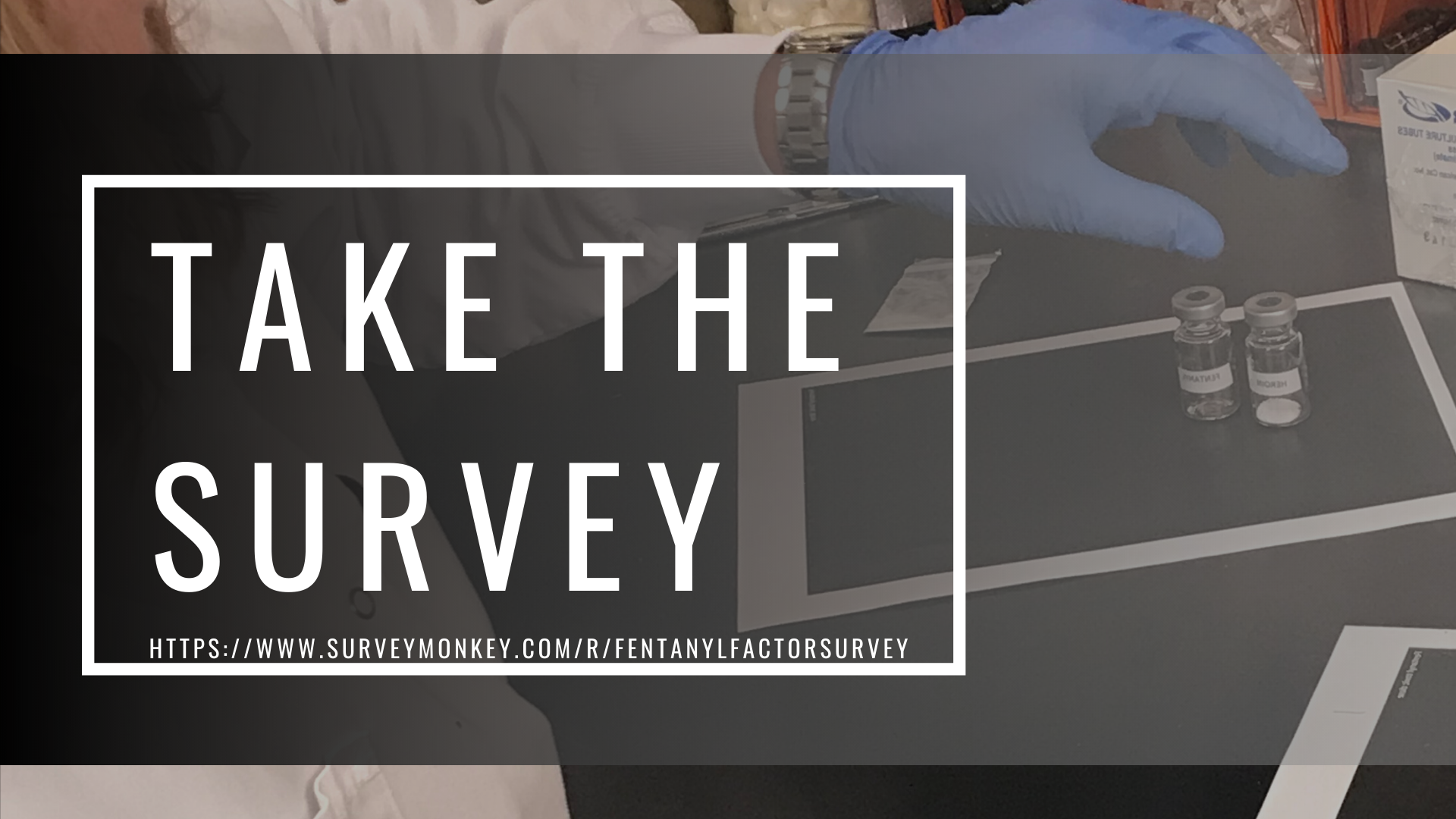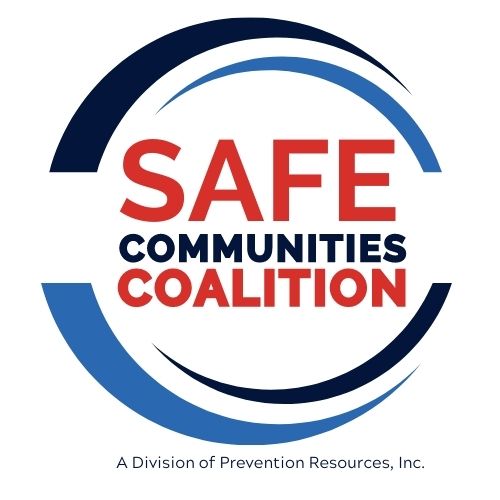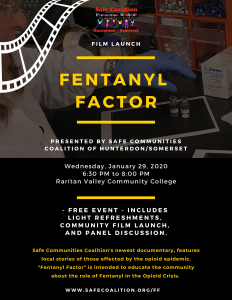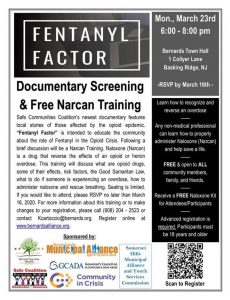- 908-782-3909
- safecoalition@njprevent.com
Safe Coalition’s newest documentary, “Fentanyl Factor”, is intended to educate the community about the role of Fentanyl in the Opioid Crisis.
“Fentanyl Factor” includes interviews from local residents and law enforcement effected by the opioid epidemic. Also features interview with a Forensic Scientist inside the lab where real and counterfeit drugs are tested.
This film highlights the alarming increase of accidental overdose deaths due to the mixing of fentanyl with other substances such as heroin, cocaine, and counterfeit prescription pills.
Facts About Opioids
Opioids are a class of drug that includes prescription painkillers and heroin.
Prescription opioids are some of the most commonly prescribed drugs. They help ease short-term pain after surgery, accident, or illness.
Heroin is also an opioid. Heroin is illegal. A doctor will never prescribe heroin.
Misuse of opioids is a leading cause of accidental death in the United States.
- Oxycodone
- Hydrocodone
- Percocet
- Vicodin
- Morphine
- Codeine
- Fentanyl
- Carfentanil
- Heroin
- Opium
- Is the prescribed medication an opioid?
– Ask why your doctor recommends that medication. - What are the risks of using opioids?
– The most serious risks are addiction and overdose, but there are other side effects. Ask your doctor to explain the risks of opioid use. - Are there other ways to manage pain?
– Ask about alternatives like ibuprofen or acetaminophen, or any physical or behavioral therapies to try. - Are opioids safe to take with my other medications?
– Many drugs, including alcohol, interact badly with opioids. Some combinations can be deadly. - How long should I take this prescription?
– Not everyone becomes addicted to opioids, but people at risk may show signs of dependency within a few days. - At what level of pain should I take this prescription?
– A doctor can help you determine when you should use an opioid or something milder. - What can I do to avoid side effects from opioids?
– Ask your doctor to give you clear directions on how to use the medication. Do not increase dosage unless approved by your doctor.
– If you are still in pain, of having troubling side-effects such as nausea, constipation, dizziness or signs of dependence, talk with your doctor. - What are signs that I may be getting addicted?
Ask your doctor to explain signs of addiction. If addiction or dependence becomes a problem, you will likely need help to stop. Talk to your doctor about addiction treatment options. - Should I have naloxone on hand?
– Ask your doctor about naloxone – a drug that can reverse the effects of an opioid overdose. Friends, family, or other bystanders could save your life if you accidentally overdose. - What should I do with opioid medication that I don’t use?
Ask your doctor to explain how to safeguard medications.
Ask about how to safely dispose of expired, unused, or unwanted medication. Find a Safe Medication Disposal Location here
If you or someone you know has an addiction to opioid drugs, talk to your doctor. Ask about naloxone and about medicated assisted treatment (MAT) options.
Recovery from opioid use disorder is possible.
- Drug overdoses are now killing more Americans under the age of 50 than any other cause.
- More than 175 people die every day from an overdose.
- Opioids are powerful pain-killing drugs.
- Opioids include legally prescribed drugs like oxycodone, hydrocodone, codeine, morphine, and fentanyl.
- Heroin, the street drug, is also illegal.
- Opioid use has risks, even if prescribed by a Doctor.
- Regular use can lead to dependence and addiction
- Opioid misuse can lead to dependence and addiction. When misused, overdose and death are possible.
- Opioid misuse can have long-lasting effects on the brain. For this reason, opioid use disorder is considered a chronic disease.
- Opioid use disorder can happen to anyone.
- 95 million Americans used opioids in the past year – more than used tobacco.
- It is common for a person misusing prescription opioids to illegally use drugs that were prescribed to a family member or friend.
- Across the US, heroin use has increased in people of all ages, across all income levels.
- A prior dependence on prescription opioids is one of the biggest risk factors for starting heroin.
- Because heroin is often injected, people are at higher risk for HIV and hepatitis.
- Fentanyl is a synthetic opioid, used for treating severe pain.
- Fentanyl is up to 100 times stronger than morphine and many more times stronger than heroin.
- The use of illegally made and sold fentanyl is on the rise.
- Fentanyl is being added to heroin.
- Fentanyl is also being added to non-opioid drugs such as cocaine, or pills made to look like drugs such as Xanax.
- Carfentanil is another very strong synthetic opioid. Just a few grains can kill someone.
- First responders should be properly trained to administer Narcan and can protect themselves from exposure by utilizing person protective equipment. Assume all powdered drugs may contain fentanyl and its analogs; don’t taste, touch or sniff suspected drugs. Avoid handling any substances or paraphernalia.
- Studies suggest that fentanyl and similar opioids are causing the increase in overdose deaths.
- The Overdose Prevention Act is a Statewide legislation (NJ) that protects people calling for help during an overdose – designed to reduce legal barriers and save lives.
- Naloxone is a drug that can reverse an opioid overdose.
- People with Opioid Use Disorder and loved ones should keep Naloxone on hand and know how to use it.
- Friends and family should know the signs of an overdose and how to use Naloxone.
- A doctor or pharmacist can tell you where to get Naloxone and how to use it. They can be sold over the counter at pharmacies.
- Opioid Use Disorder can be treated.
- Medication Assisted Treatment (MAT) can help control addiction.
- MAT often involves both medication and counseling.
- Even with treatment, it is not unusual for a person with an opioid use disorder to relapse (go back to using drugs) at least once.
- It takes time to replace addictive behaviors with coping skills.
- A person’s tolerance (how much of a drug a person needs to feel effects/tolerate) will lower with nonuse of the drug. An opioid relapse can be deadly. Have naloxone on hand.
- If you are concerned about Opioid dependence or addiction in yourself, or someone you care about – REACH OUT. Speak with a doctor, clergy, hotlines, or your local resource agency for possible options. Treatment is available. Recovery is possible.
Opioid overdose deaths are on the rise. This increase is mostly due to an opioid drug called fentanyl, which is many times more powerful than heroin. Fentanyl is being added to heroin, counterfiet pills, and other illegal drugs. People may not even know they are using fentanyl until it’s too late. Get the facts about this dangerous drug.
What is Fentanyl?
- Fentanyl is a powerful prescription painkiller. Doctors may prescribe it in cases of severe pain.
- Fentanyl is a synthetic opioid, which means it can be made in a lab. Street-drug suppliers may not know the strength of a particular batch of fentanyl. This increases the risk of overdose in users.
Illegal fentanyl has become more common.
- Sometimes prescription fentanyl ends up illegally sold on the street.
- Other times, it is illegally made, or brought in from other countries.
- Because it is relatively cheap, fentanyl is being added to heroin and other illegal drugs.
What are counterfeit pills?
- Illegal pills are made to copy the look of common prescription drugs such as Oxycodone, Percocet, Vicodin, Xanax, and others.
- These counterfeit or “fake” pills often have fentanyl added to them.
- The people who buy and use these drugs may not know that the pills contain fentanyl.
Why is fentanyl so dangerous?
- Fentanyl is 30 to 50 times stronger than heroin. This means its effects come on more strongly and much more quickly than with other opioid drugs.
- Fentanyl slows down a person’s breathing and heart rate. When too much is taken, fentanyl can quickly cause death.
Carfentanil is another very powerful synthetic opioid being added to street drugs. Just a few grains of carfentanil can kill a person.
Who is at risk of a fentanyl overdose?
- Heroin users who may not know fentanyl has been added to the heroin.
- Anyone who uses other drugs to which fentanyl has been added, including MDMA (ecstasy), cocaine, and counterfeit pills.
- A person who is relapsing (using drugs after quitting or going through drug treatment) has an increased chance of overdosing because their body is no longer used to the drug.
Signs of Opioid overdose
- loss of consciousness
- pinpoint pupils
- slowed breathing
- slow or erratic heart rate
- vomiting
- cold, clammy skin or skin that has turned blue or gray
- seizures
- symptoms can occur right away
Naloxone is a drug that can reverse an opioid overdose.
- A person who uses opioids or other drugs that may have fentanyl should always have naloxone on hand.
- If a person shows signs of overdose, call 911 ang give naloxone right away. More than one dose may be needed.
- Ask your doctor or pharmacist about where to get naloxone and how to use it.
Resources

https://njprevent.com/resources/
Prevention Resources, Inc. (908-782-3909) // Level 1 treatment services, Substance abuse evaluations, counseling, anger management, interventions, prevention education, and more. www.njprevent.com
- Safe Communities Regional Coalition – Prevention and community strategies to prevent and reduce substance use
- Family Support Center – for loved ones of those struggling with substance use
- Recovery Center of Hunterdon – peer-recovery support
- Family Success Center (908-237-0465) programs, resources, and information
Crime Stoppers of Hunterdon County (800-321-0010) ANONYMOUSLY report a crime. download the smartphone app: “P3 Hotlines Tips” www.crimestoppershunterdon.com
*THIS IS A LIMITED LIST. FOR MORE INFORMATION PLEASE CALL PREVENTION RESOURCES, INC.
- ReachNJ 1-844-REACH-NJ (1-844-732-2465) Serves to simplify the process for those seeking help from addiction. www.ReachNJ.gov
- NJ ADDICTION SERVICES HOTLINE 844-276-2777 // Provides information and referral to substance use treatment statewide
- NJ CONNECT FOR RECOVERY 855-652-3737 // Dedicated to opioid addiction, serves both the person struggling with addiction as well as their loved ones
- NJ MENTALHEALTHCARES 866-202-4357 // Directs callers to appropriate service entry points
- 2NDFLOOR 888-222-2228 // Confidential and anonymous helpline for New Jersey’s young people
- N.J. HOPE LINE 855-654-6735 // Peer Support and Suicide Prevention Hotline
- SAMHSA’s National Hotline 1-800-662-HElp (4357) treatment referral and information service (in English and Spanish) for individuals and families facing mental and/or substance use disorders
*THIS IS A LIMITED LIST. FOR MORE INFORMATION PLEASE CALL PREVENTION RESOURCES, INC.

www.surveymonkey.com/r/FentanylFactorSurvey
https://www.surveymonkey.com/r/FentanylFactorSurvey
Special Thanks
www.njprevent.com
www.safecoalition.org
Raritan Valley Community College
Hunterdon County Prosecutor’s Office
Sheriff Fred Brown, Hunterdon County
Flemington Police Department
New Jersey State police
Deb Len, Central NJ GRASP
Family of Harry Hillard
Funding Provided By
www.crimestoppershunterdon.com
www.onevoicehc.com
www.clintonsunriserotary.com
https://portal.clubrunner.ca/14785
partnershipforhealth.hunterdonhealthcare.org
www.state.nj.us/humanservices/dmhas
Community Film Showing Events
IN THE NEWS
https://www.cadca.org/resource-types/coalitions-online
February 17, 2020
https://www.pbs.org/video/community-corner-lesley-gabel-qinvsx/
COMMUNITY CORNER: Lesley Gabel, co-CEO and executive director of Prevention Resources Inc. in Flemington, N.J. the Fentanyl Factor. MONICA
February 26, 2020
Safe Coalition – Safe Communities Coalition of Hunterdon/Somerset has officially launched the Fentanyl Factor documentary on their website. The documentary is intended to educate the community about the role of Fentanyl in the Opioid Crisis and features local stories of those affected by the epidemic. To view the documentary, please click here.
March 27, 2020
“The toll of opiates on youth over the past decade is staggering – more the half a million overdose deaths. A new documentary, “Fentanyl Factor,” depicts in heartbreaking detail a handful of the young lives swept away by an extremely potent synthetic opiate, Fentanyl, all of whom were from Hunterdon or Somerset counties. Family members showed remarkable strength reliving their loss in interviews in the movie and as members of a panel at a screening of the film January 29 at Raritan Community College.
Each of the stories the movie presents captures the unbearable pain at seeing a young life teeming with promise eliminated by addiction; each shows a young man who falls into drug use and fentanyl delivering the death blow. As several people in the film and on the panel said, “We are not meant to bury our children.” This makes High Point’s treatment for substance use particularly critical. High Point provides medication assisted treatment for opiate addiction, which includes suboxone and vivitrol.
One particularly poignant story came from a mother who appears in the film and also sat on the panel at the college. An overdose left her son comatose and placed on life support. It became clear he would not emerge from the coma. The movie places this woman in a serene setting – a beach with gentle waves lapping the shoreline. She is talking about the day she accepted it was time to take her son off of life support: his birthday. In the movie, she speaks of his birth and hearing his first heartbeat, and also his last.
The goal of the movie, which will be widely distributed in the coming months is to raise awareness about Fentanyl and its potency (100 times more potent than morphine). A lethal does is the equivalent of a pinch of salt in volume. One of the panel members, a woman who lost her brother to fentanyl, said before his death she knew nothing about it; now it assumes an oversize role as she strives to spare others losing a beloved sibling or child or spouse to overdose.
The panel also featured three officials who have focused a great deal on the issue of drug addiction: State Senator Kip Bateman, Hunterdon Acting Prosecutor Michel Williams and former Hunterdon Prosecutor Anthony Kearns. Before he stepped down as prosecutor, Kearns convened a town hall in 2019 on the opiate issue and it continues to be an issue he is committed to fighting. He stressed that has prosecutor he saw the toll on families of all backgrounds, races, creeds; addiction is blind to those aspects of a person’s life.
The three took note of one of the factors that continues to frustrate an appropriate response to addiction – refusal to accept addiction as a disease. This stigma still causes many to continue to view addiction as a weakness. Watching “Fentanyl Factor” will surely help dispel that misconception.
One young man on the panel, Sean, is committed to banishing that misconception. He said a person’s first use of an opiate may be of his or her choice, but before long, the drug usurps the brain’s capacity for anything approaching rational decision-making. Sean, now more than eight years in recovery, has revived the inner-light addiction had dimmed. Now he “aspires to inspire until he expires,” as he puts it.
Fentanyl had multiplied the loss of life caused by the opiate crisis. The “Fentanyl Factor” offers a lament of the young lives the drug taken by this drug and the shattered families they leave behind. Making it compulsory viewing for students, beginning with middle schoolers, could well preserve thousands of youth. The film illustrates how the youthful sense of invincibility – the “it won’t happen to me” syndrome – does not apply here.
The film was presented by the Safe Communities Coalition of Hunterdon/Somerset.”


